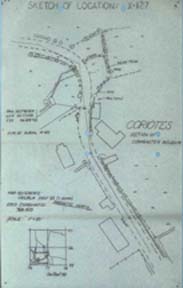|
ordered by date created after Context & Composition |
|
The German Ardennes Offensive began December 16, 1944, along an 80-mile front. Now known as the Battle of the Bulge, it remains the largest battle ever fought by the United States Army. The Germans met with initial success in most parts of their central thrust, spearheaded by Battle Group Peiper. Their plan was for the central thrust (by Sixth SS and Fifth Panzer Armies) to be buffered by parallel thrusts to the north (Fifteenth Army) and south (Seventh Army), which would prevent American reinforcements from reaching the flanks of the main thrust toward Antwerp. However, the American troops on the northern shoulder held most of their ground, thanks to the efforts of the 99th and 2nd Infantry Divisions. This allowed the U. S. 7th Armored Division to move, on the morning of December 17, from north of Aachen, Germany to the center of the front, at St. Vith, Belgium. The move was made on an eastern route bound for St. Vith and a western route bound for Vielsalm. The 814th Tank Destroyer Battalion was not an organic element of 7th Armored Division but was attached to 7AD in August 1944 for the duration of the war in Europe. 814 TD moved south in the western column, arriving at Vielsalm late on December 17. Although the front lines to the east at St. Vith stopped the German advance, German units penetrated westward to the north and to the south of the defenses. By December 19, the Germans had penetrated far to the west of St. Vith on the south, to the point where normally rear echelon supply units came under attack 20 miles and more west of St. Vith. On December 23, the entire force under 7th Armored Division was withdrawn from the salient to west of the Salm River. The withdrawal in daylight, under constant attack by the enemy, was done in phased steps. Mostly things went as planned. But for some units, particularly including elements of 814th Tank Destroyer Battalion as one of the last units to withdraw, the enemy suceeded in inflicting losses of personnel and vehicles. One of those vehicles lost was C/814 tank destroyer #40177750, labeled C-22 for marches. It was hit at Commanster, Belgium, and abandoned in a stream. At least one member of the crew was killed: Pvt. Paul H. Espig. Someone -- probably either German soldiers or Belgian civilians -- buried him there. In late March 1945, the American Graves Registration Service was notified of the isolated burial. On 4 May 1945, a GRS unit working out of the temporary U. S. Military Cemetery at Foy, Belgium, recovered the remains and labeled them as Unknown X-127 (Foy). This web page is about these men of the 814th Armored Division and their role in the combat that took at least one of their lives and may have left others wounded or captured. There has been an absence until now of detailed material about this event, and this web page is intended to provide that detail, to bring to light the men and events of this little-known part of the battle. -- Wesley Johnston, Historian, 7th Armored Division Association |
|
Pvt. Paul H. Espig was apparently a crew member of C/814 tank destroyer #40177750 with march serial C-22 that was knocked out at Commanster 23 Dec 1944. Someone buried his remains in an isolated grave near the tank destroyer. He was recovered 4 May 1945 by a team from the 610th Quartermaster Graves Registration Company who could not identify him and labeled his remains Unknown Foy X-127. In September 1948, he was identified through private dental records sent by his family. His Individual Deceased Personnel File (IDPF) and the file for Foy X-127 would normally have been combined into his IDPF. But the lateness of the identification apparently led to the two files being kept separate. 7th Armored Division Association Historian Wesley Johnston has now combined the two files into one, which can be seen by clicking here. In particular, the 4 May 1945 "Report of Investigation of Isolated Grave or Unburied Remains" (PDF pp 12-14) includes the following detailed map of the location of the tank destroyer and the grave. 
Click on image for full size. |